The Psychology of the Canadian Petro-dollar
More than 100,000 Iraqi soldiers backed up by 700 tanks invaded the Gulf state of Kuwait in the early hours of August 2, 1990. Saddam Hussein threatened to turn Kuwait city into a "graveyard" if any other country dared to challenge the "take-over by force". In the weeks prior to the invasion, Saddam accused Kuwait of flooding the world market with oil and has demanded compensation for oil produced from a disputed oil field on the border of the two countries.
In response to the news of the invasion the price of oil rose more than doubled to as high as $40 per barrel, and stock markets around the world plunged amid fear of an energy crisis. But in those days, the British pound was regarded as the world's "Petro-currency", and a favorite trade was to buy British pounds and sell Japanese yen, whenever the price of oil rose, and reverse the trade when oil fell.
However, British North Sea oil production peaked at 2.9 million bpd in 1999 and has been in a long-term decline ever since. Since 2004, the UK has been a net importer of natural gas. According to figures from the Royal Bank of Scotland, oil production from the UK continental shelf fell to 1.5 million bpd in October, or 14% lower from October 2004. If correct, then the UK could become a net oil importer by 2007.
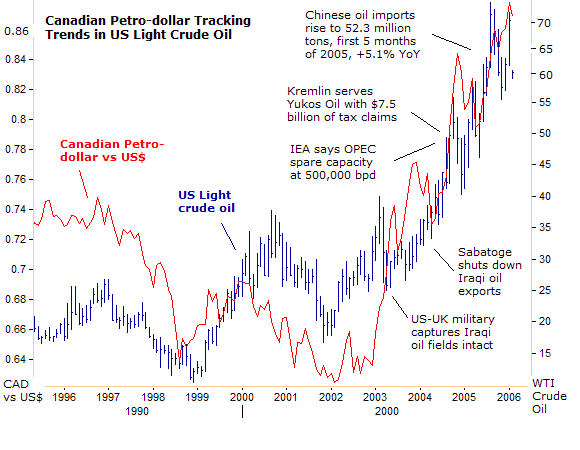
After the price of US light crude oil jumped above the psychological $40 per barrel level in 2004, global investors began to take a harder look at the underground oil deposits around northeastern Alberta, Canada that hold about 1.6 trillion barrels of oil, the largest lode of hydrocarbons on Earth. Soon after, Canada's "Loonie" was anointed as the heir of the British pound, and bestowed the coveted position as the world's Petro-currency. And over the past 12-months, US crude oil futures have traded in the same direction as Canada's Petro-dollar about 74% of the time.
Long regarded as a "commodity currency" the demand for the Loonie is increasingly linked to the direction of energy, gold and base metal shares. Nearly half of the market capitalization of the benchmark Toronto Stock Exchange index is linked to the energy and materials sectors. Canadian exports, led by the energy sector, surged to a record $C41.3 billion in December 2005, up 3.9% from November, despite a Canadian dollar that is gyrating at highest level since the early 1990's.
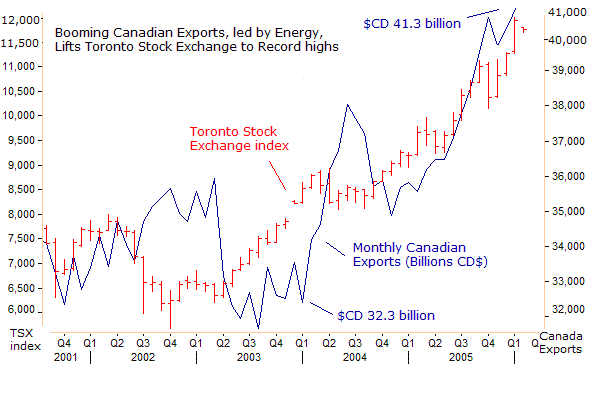
Canada's trade surplus with the United States hit a record $C11.6 billion in December, as energy exports jumped 11.2% to a record high of $C9.3 billion, led by a surge in natural gas shipments. Total exports advanced to a record high of $C423.6 billion in 2005, compared with $C408.9 billion in 2004. Imports also hit a record high, rising 8.8% to $C413.8 billion. Canadian exports rose even as the Loonie climbed from an average 77 US-cents in 2004 to 83 US-cents in 2005.
Geologists estimate that anywhere from 175 to 330 billion barrels of the molasses-like crude in Canada's oil sands region are recoverable. Saudi Arabia, by contrast, possesses 262 billion barrels of proven reserves. Over the next decade, nearly two dozen companies from Canada, the United States, France and China are planning an estimated $100 billion in oil sands projects, and few countries can match growth on that scale. Longer term, there's only really one rival and that's Saudi Arabia.
Current production in the Oil Sands region is about one million barrels a day, about half of which goes to the US by pipeline. Production is forecast to rise to 2 million barrels a day by 2010 and possibly 3.9 million a day by 2015. The Saudis can pump oil at a cost of $2 to $3 a barrel, but converting the molasses-like sands of Alberta into useable crude requires substantial manpower, technology and energy. After adding capital costs, shipping and depreciation, sands producers need per-barrel global prices above the $C18-to-$23 level.
The USA guzzles more than 21 million barrels a day, about 62% of which is imported. Daily US demand is projected to climb to 23 million barrels by 2010, while domestic production falls. So the US is looking to its friendly neighbor to the north to help satisfy its thirst for oil, and reduce its reliance on the Persian Gulf oil kingdoms, unstable Nigeria, and Hugo Chavez of Venezuela. Crude oil prices command a high premium due to the instability of the countries that produce it.
Russia, Vladimir Putin's demonstrated to the Ukraine and the rest of Europe his ability to use energy exports as economic and political weapon. Rebels are destabilizing Nigeria's oil industry's infrastructure in a campaign to establish control over the country's wealth and to impose Muslim rule. On February 20th, Royal Dutch Shell was forced to shut down 455,000 bpd of production in the Nigerian Delta.
Venezuela's Hugo Chavez, has formed an alliance with Iran's Ayatollah and threatened to interrupt oil supplies to the US and at some point, may decide to do so. And the Ayatollah in Tehran is bent on acquiring nuclear weapons, calling for the "destruction of Israel" and "a world without America" and could unleash the oil weapon in retaliation for economic sanctions.
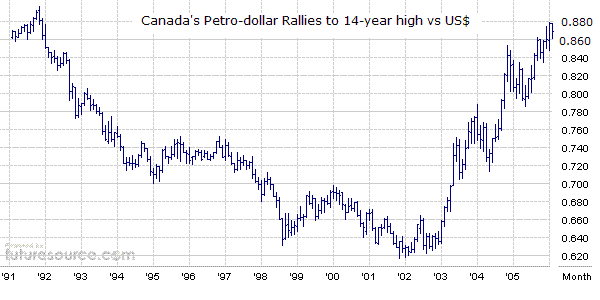
However, Canada is a safe haven and reliable supplier of energy for its southern neighbor. The United States imported 2.3 million barrels per day of crude and refined products from Canada last year, a million barrels more per day than from Riyadh, exceeding imports from the Saudis every year since 1999. Canada is America's single biggest supplier of foreign oil, providing 17% of all US oil imports.
But cash rich Beijing is also eyeing direct investments in Canadian oil sands projects, and might want to ship increasing amounts of oil to China in the future at the expense of United States. Former Canadian natural resources minister John McCallum foresaw China taking as much as 400,000 bpd, or 25% of the oil currently being shipped to America.
Last spring, Canadian pipeline giant Enbridge (ENB.TO) signed a deal with Petro-China to anchor a new $2.5-billion oil sands pipeline to the West Coast, then shipping on tankers to Asian markets, including China. Beijing is recycling its immense trade surpluses by buying up oil, coal, natural gas, and other energy assets on multi-billion-dollar deals with Africa, Iran, Indonesia, Australia and Venezuela.
But total trade volume between Canada and China is only $30 billion compared with $500 billion between Canada and the United States. And much to the dismay of Beijing, Canada's newly elected Conservative leader Stephen Harper is expected to pursue much closer ties with the US, in contrast to former Liberal leader Martin, who played the China energy card in trade disputes with the US.
India has also jumped into the intense competition for Canadian oil sands assets with plans to invest $1 billion over the next 12 months, to help power its growing economy, said M.S. Srinivasan, secretary of India's Ministry of Petroleum & Natural Gas. "There are countries where opportunities are extremely limited, and the window of opportunity is limited. Some competition with China is unavoidable.
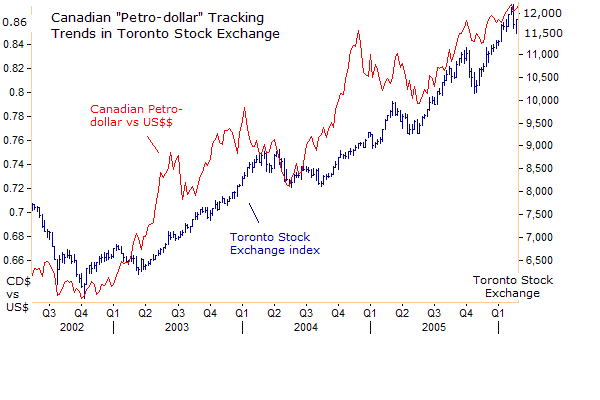
Exports of commodities account for roughly 13.5% of Canada's C$1.1 trillion economy, the world's eighth largest. Nearly 34% of Canada's exports are energy-related, and metals are roughly 15 percent. For better or worse, the psychology of the foreign currency market is fixated on the price of crude oil, gold, and base metals when setting the price of the Canadian dollar, against the Japanese yen and US dollar, and by default the Chinese yuan. As a result, the Canadian dollar is expected to remain strong for a long time, wrecking havoc on manufacturers in Ontario.
A sizeable economic gap is developing between resource-rich provinces in Alberta, British Columbia, and Newfoundland, riding the wave created by the resource boom, versus central Canada's manufacturing base, in Ontario, Quebec, and New Brunswick. Manufacturers are getting hammered by a flood of cheap Chinese imports, made cheaper by a strong Loonie. British Columbian exports of lumber could also drop from a US housing slowdown. However, Canada as a whole is expected to grow 3% in 2006, just a bit stronger than the 2.9% pace in 2005.
For Canada's manufacturing sector, more than half of which is located in Ontario. January was a brutal month, with an estimated 41,600 factory jobs lost, the biggest one-month drop in 15 years. Ontario saw 33,000 manufacturing jobs disappear last month, taking the province's total cuts to 93,000 since the end of 2002, just before the Loonie began its 37% appreciation against the US dollar.
Canada's factory sector employs 2.13 million people, and started cutting about 145,000 payroll positions over the past 12 months. But the government employed 42,800 more people in January, including temporary staff hired for Canada's Jan. 23rd federal election, and natural resource companies hired another 12,300 workers. So the Bank of Canada governor David Dodge is focusing on the economy as a whole and has signaled the need to lift interest rates back to more neutral levels in order to keep inflation pressures under control.
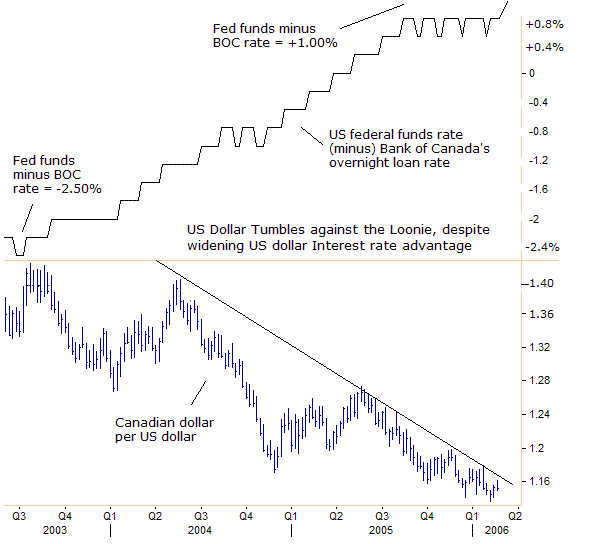
On February 6th, Dodge said oil prices could rise further, which could have an negative impact on Canadian inflation. "Total consumer price inflation, which was at 2.3% in the fourth quarter of 2005, has been and will continue to be affected by changes in the prices of crude oil and natural gas. Some modest and further increase in the policy interest rate would be needed to keep aggregate supply and demand in balance and inflation on target over the medium term," he said.
Ironically, the US dollar has tumbled from about 1.40 Canadian dollars to just below 1.15 Canadian dollars while interest rate differentials have moved decidedly in the US dollar's favor by 350 basis points. In this rare situation, the enormous flow of foreign capital into Canada's resource-rich capital markets has overpowered the influence of short-term interest differentials between the two currencies.
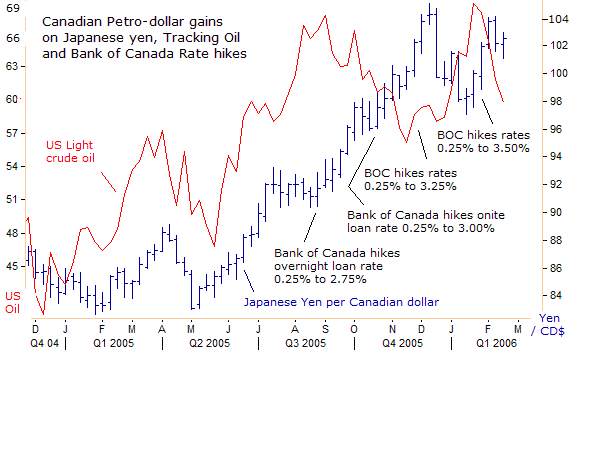
Four quarter-point rate hikes by the Bank of Canada to 3.50% over the past six months went un-opposed by the Bank of Japan, providing additional incentives for Japanese "carry traders" to bid the Petro-dollar 23.8% higher to as high as 104-yen last year. Canadian and Detroit car manufacturers are feeling the heat from a weaker yen, while others succumb to a weaker Chinese yuan. Canada's economy is in danger of losing more of its manufacturing base, while transitioning to a service sector economy, which accounts for two-thirds of output.
BOC's Dodge has issued empty warnings to Asian countries about the dangers of fixed foreign exchange rates, and said they needed to show commitment to a renewed international monetary order and "play by the rules," in regards to China and Japan. However, the BOC is still expected to match the next two Federal Reserve rate hikes, by pushing its overnight loan rate to 4.00% in the months ahead, bolstering the Canadian dollar against the Chinese yuan and Japanese yen.
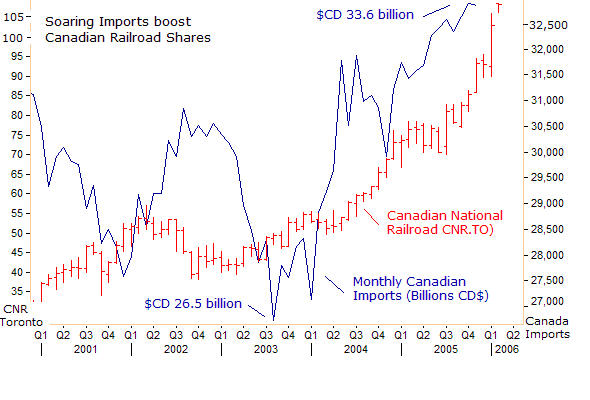
Canadian imports hit an all-time high of $C33.6 billion in December, largely due to substantial growth in trade volumes with Pacific Rim countries flowing through the Port of Vancouver. Canadian National Railway (CNR.TO) posted a 14% jump in fourth-quarter earnings on January 25th, crediting stronger pricing and productivity gains. Canada's largest railroad and fifth biggest in North America, also announced a two for one stock split in the form of a stock dividend and a 30% increase in its quarterly cash dividend, boosting its stock price to an all-time high of $C109.
In addition to a booming resource sector, the Loonie was the only currency among the big-7 industrialized economies to enjoy both trade and budget surpluses. In 2000, there was a budget surplus of more than 2% of GDP, rising to 4% by 2001. Since then, annual budget surpluses have been shrinking and almost disappeared in fiscal 2005, leaving less money to pay down the $C500 billion federal debt.
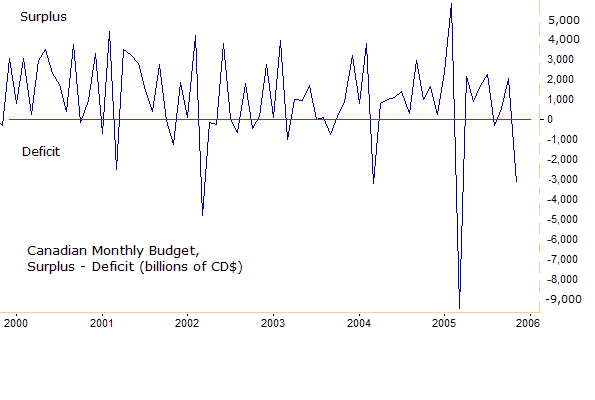
There was a potential for a $13.4 billion surplus in fiscal 2006, but the newly elected conservative government promised to use up most of the projected surpluses for tax cuts and different spending priorities. PM Harper aims cut to dividend taxes, offer accelerated capital-tax elimination for businesses, corporate tax rate reductions by 2010, and allow Canadian investors to defer capital gains tax so long as they are replacing one taxable asset with another. And that's the icing on the cake for happy investors in the Toronto Stock Exchange and the Canadian "Petro-dollar."

This article is dedicated to the current and future Canadian subscribers to the Global Money Trends magazine.
This article may be re-printed for use in other publications with links to www.sirchartsalot.com. If you are interested in reading our analysis of gold, foreign currencies, foreign stock and bond markets, crude oil, and natural resource stocks, and US listed iShare ETF's, for as little as $90 per year for 24 issues, click on this link to subscribe now or request a, Free Trial Newsletter.
Mr Dorsch worked on the trading floor of the Chicago Mercantile Exchange for nine years as the chief Financial Futures Analyst for three clearing firms, Oppenheimer Rouse Futures Inc, GH Miller and Company, and a commodity fund at the LNS Financial Group.
As a transactional broker for Charles Schwab's Global Investment Services department, Mr Dorsch handled thousands of customer trades in 45 stock exchanges around the world, including Australia, Canada, Japan, Hong Kong, the Euro zone, London, Toronto, South Africa, Mexico, and New Zealand, and Canadian oil trusts, ADR's and Exchange Traded Funds.
Mr Dorsch wrote a weekly newsletter from 2000 thru September 2005 called, "Foreign Currency Trends" for Charles Schwab's Global Investment department, featuring inter-market technical analysis, to understand the dynamic inter-relationships between the foreign exchange, global bond and stock markets, and key industrial commodities.
















